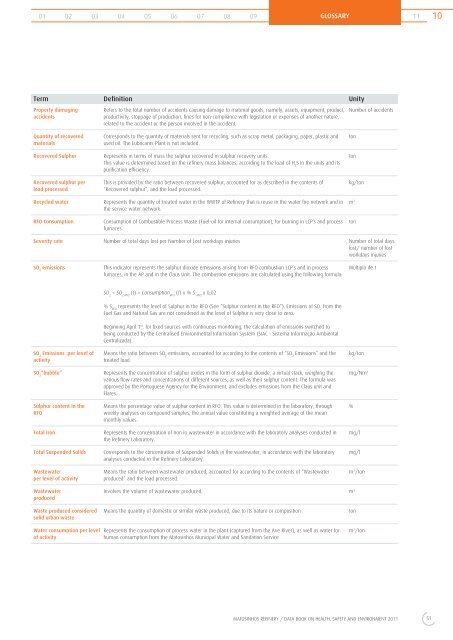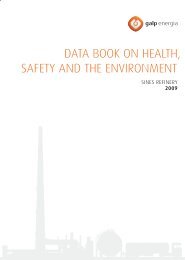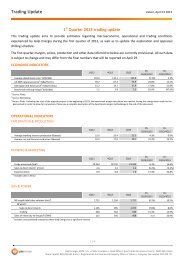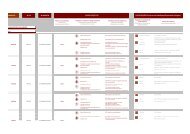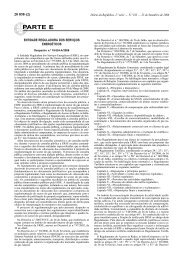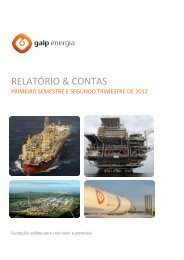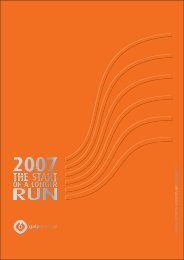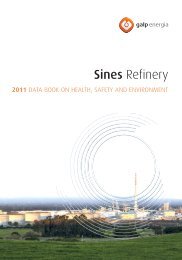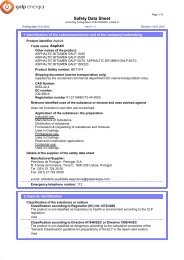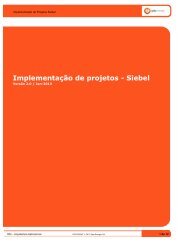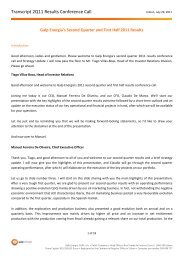2011 Matosinhos Data Book - Galp Energia
2011 Matosinhos Data Book - Galp Energia
2011 Matosinhos Data Book - Galp Energia
You also want an ePaper? Increase the reach of your titles
YUMPU automatically turns print PDFs into web optimized ePapers that Google loves.
01<br />
02<br />
03<br />
04<br />
05<br />
06<br />
07<br />
GLOSSARY<br />
08 09 11<br />
Term Defi nition Unity<br />
Property damaging<br />
accidents<br />
Quantity of recovered<br />
materials<br />
Refers to the total number of accidents causing damage to material goods, namely, assets, equipment, product,<br />
productivity, stoppage of production, fi nes for non-compliance with legislation or expenses of another nature,<br />
related to the accident or the person involved in the accident.<br />
Corresponds to the quantity of materials sent for recycling, such as scrap metal, packaging, paper, plastic and<br />
used oil. The Lubricants Plant is not included.<br />
Recovered Sulphur Represents in terms of mass the sulphur recovered in sulphur recovery units.<br />
This value is determined based on the refi nery mass balances, according to the load of H 2 S in the units and its<br />
purifi cation effi ciency.<br />
Recovered sulphur per<br />
load processed<br />
This is provided by the ratio between recovered sulphur, accounted for as described in the contents of<br />
“Recovered sulphur”, and the load processed.<br />
Recycled water Represents the quantity of treated water in the WWTP of Refi nery that is reuse in the water fi re network and in<br />
the service water network.<br />
RFO Consumption Consumption of Combustible Process Waste (Fuel-oil for internal consumption), for burning in LCP´s and process<br />
furnaces.<br />
Number of accidents<br />
Severity rate Number of total days lost per Number of Lost workdays injuries Number of total days<br />
lost/ number of lost<br />
workdays injuries<br />
SO 2 emissions This indicator represents the sulphur dioxide emissions arising from RFO combustion LCP´s and in process<br />
furnaces, in the AP and in the Claus Unit. The combustion emissions are calculated using the following formula:<br />
SO 2 Emissions per level of<br />
activity<br />
SO 2 = SO 2 RFO (t) = Consumption RFO (t) x % S RFO x 0,02<br />
% S RFO represents the level of Sulphur in the RFO (See “Sulphur content in the RFO”). Emissions of SO 2 from the<br />
Fuel Gas and Natural Gas are not considered as the level of Sulphur is very close to zero.<br />
Beginning April 1 st , for fi xed sources with continuous monitoring, the calculation of emissions switched to<br />
being conducted by the Centralised Environmental Information System (SIAC - Sistema Informação Ambiental<br />
Centralizada).<br />
Means the ratio between SO 2 emissions, accounted for according to the contents of “SO 2 Emissions” and the<br />
treated load.<br />
SO 2 ”bubble” Represents the concentration of sulphur oxides in the form of sulphur dioxide, a virtual stack, weighing the<br />
various fl ow rates and concentrations of different sources, as well as their sulphur content. The formula was<br />
approved by the Portuguese Agency for the Environment, and excludes emissions from the Claus unit and<br />
Flares.<br />
Sulphur content in the<br />
RFO<br />
Means the percentage value of sulphur content in RFO. This value is determined in the laboratory, through<br />
weekly analyses on compound samples, the annual value constituting a weighted average of the mean<br />
monthly values.<br />
Total Iron Represents the concentration of Iron in wastewater in accordance with the laboratory analyses conducted in<br />
the Refi nery Laboratory.<br />
Total Suspended Solids Corresponds to the concentration of Suspended Solids in the wastewater, in accordance with the laboratory<br />
analyses conducted in the Refi nery Laboratory.<br />
Wastewater<br />
per level of activity<br />
Wastewater<br />
produced<br />
Waste produced considered<br />
solid urban waste<br />
Water consumption per level<br />
of activity<br />
Means the ratio between wastewater produced, accounted for according to the contents of “Wastewater<br />
produced” and the load processed.<br />
Involves the volume of wastewater produced. m 3<br />
Means the quantity of domestic or similar waste produced, due to its nature or composition ton<br />
Represents the consumption of process water in the plant (captured from the Ave River), as well as water for<br />
human consumption from the <strong>Matosinhos</strong> Municipal Water and Sanitation Service<br />
MATOSINHOS REFINERY / DATA BOOK ON HEALTH, SAFETY AND ENVIRONMENT <strong>2011</strong><br />
ton<br />
ton<br />
kg/ton<br />
m 3<br />
ton<br />
Múltiplo de t<br />
kg/ton<br />
mg/Nm 3<br />
%<br />
mg/l<br />
mg/l<br />
m 3 /ton<br />
m 3 /ton<br />
51<br />
10


